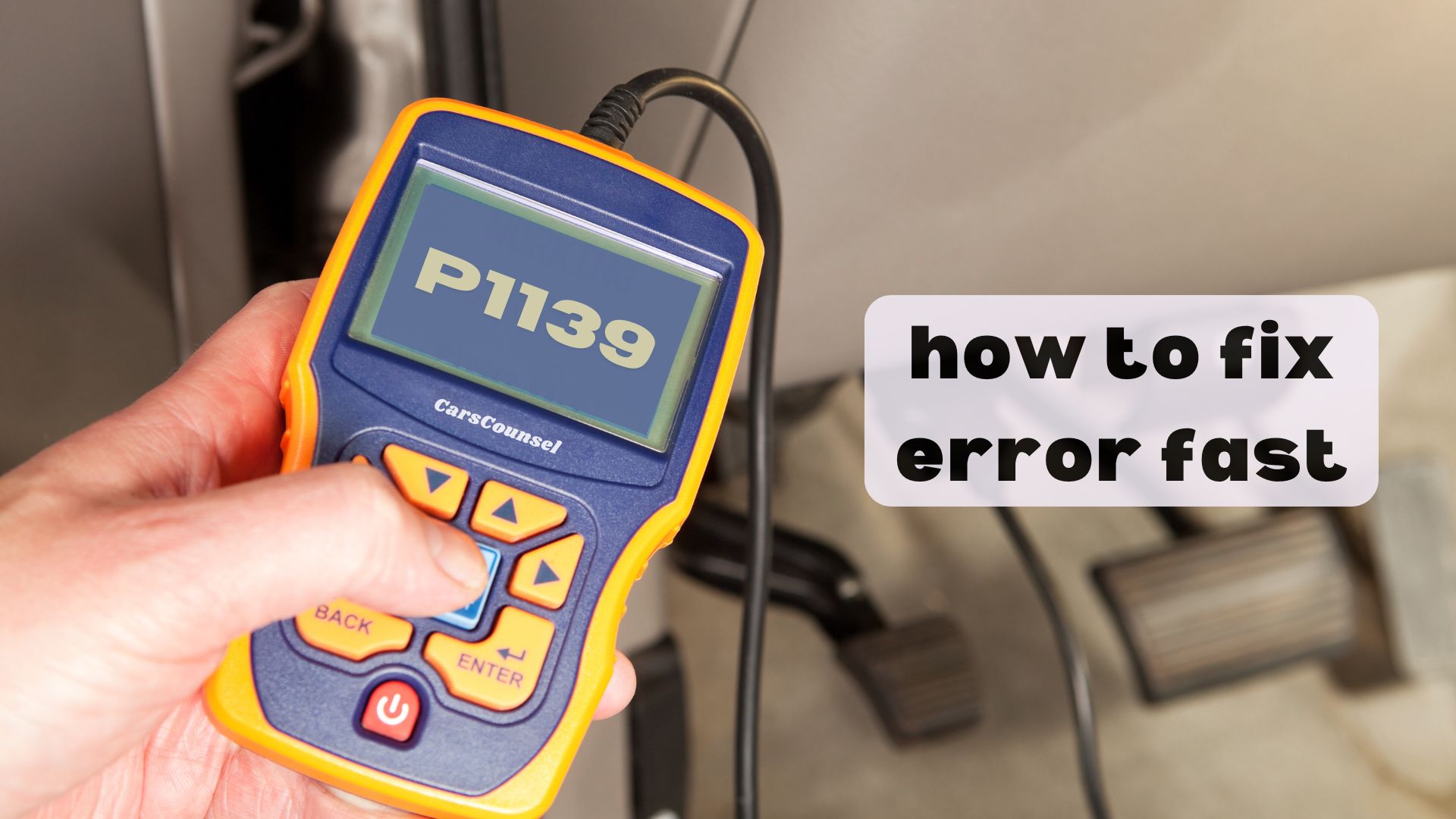When you encounter the P1139 code, it means your vehicle’s Long Term Fuel Trim Additive for Bank 2 is too rich, indicating excessive fuel delivery. This imbalance can lead to decreased fuel efficiency and potential engine damage. You’ll need to examine causes like faulty oxygen sensors, clogged fuel injectors, or vacuum leaks. Diagnosing these issues promptly is essential to restore the proper air-fuel ratio. Now, let’s investigate how to tackle this problem effectively.

Quick Navigation
Key Takeaways
- P1139 indicates a rich fuel mixture in Bank 2’s Long Term Fuel Trim system.
- Causes include faulty oxygen sensors and clogged fuel injectors.
- Vacuum leaks and malfunctioning mass airflow sensors also contribute.
- Symptoms include decreased fuel efficiency and engine hesitation.
- Diagnosis involves checking oxygen sensors and fuel injectors for malfunctions.
Understanding the P1139 Code
Understanding the P1139 Code involves recognizing it as an indication of a rich fuel mixture in the Long Term Fuel Trim Additive system for Bank 2.
This imbalance results from excess fuel delivery relative to air, affecting emissions control by increasing emissions and reducing fuel efficiency.
The P1139 code is a diagnostic tool used to identify issues such as faulty oxygen sensors or clogged fuel injectors that disrupt proper fuel delivery.
Addressing these issues is essential to restore ideal engine performance and emissions control.
Causes of a Rich Fuel Mixture
When diagnosing a rich fuel mixture indicated by the P1139 code, you’ll typically encounter issues that lead to an excessive amount of fuel being delivered relative to air.
This disrupts the ideal air-fuel ratio, causing inefficiencies. Common causes include faulty oxygen sensors, clogged fuel injectors, vacuum leaks, and malfunctioning mass airflow sensors.
These issues can skew the fuel mixture, leading to a rich condition that affects engine performance and emissions. Addressing these problems is vital to restore the proper air-fuel ratio and prevent further damage.
Symptoms of the P1139 Code
Symptoms of the P1139 code typically manifest as a result of a rich fuel mixture, which disrupts the ideal air-fuel ratio. This imbalance affects fuel efficiency and engine performance. Common symptoms include decreased fuel efficiency, rough idling, and engine hesitation.
| Symptom | Description | Impact |
|---|---|---|
| Fuel Efficiency | Decreased fuel economy | Increased costs |
| Engine Performance | Rough idling, stalling | Reduced reliability |
| Engine Hesitation | Misfires during operation | Safety concerns |
| Exhaust Odor | Strong gasoline smell | Environmental impact |
| Check Engine Light | Illuminated warning | Diagnostic necessity |
Diagnosing the P1139 Issue
To diagnose the P1139 code, which indicates a long-term fuel trim too rich condition in Bank 2, you’ll need to systematically evaluate several key components.
Start by checking the oxygen sensor readings and fuel injector operation to identify any malfunctions.
Inspect for vacuum leaks and assess the mass airflow sensor’s performance.
These steps will help pinpoint issues affecting engine performance.
Analyzing fuel trim data can also reveal imbalances in the air-fuel ratio, guiding further diagnostic efforts.
Repairing the P1139 Code
Repairing the P1139 code involves addressing the underlying causes of the rich fuel mixture in Bank 2.
You’ll need to diagnose and fix issues like faulty oxygen sensors or clogged fuel injectors. Replace any faulty oxygen sensors to guarantee accurate air-fuel ratio readings.
Clean or replace clogged fuel injectors to restore proper fuel delivery. Additionally, inspect for vacuum leaks and malfunctioning mass airflow sensors, addressing these issues to prevent further engine problems.
Reset the engine control module after repairs to clear the trouble code.
Cost Considerations for Repairs
When addressing the P1139 code, you’ll encounter varying costs depending on the specific cause and the local labor rates.
The average repair cost ranges from $200 to $500 for parts and labor. Diagnostic fees can add to the overall expense, as identifying the root cause—such as faulty oxygen sensors or clogged fuel injectors—is essential.
It’s advisable to get quotes from trusted mechanics to understand the full scope of the repair cost, including any additional diagnostic fees. This will help you budget effectively for the necessary repairs.
Preventing Future Issues
After addressing the P1139 code by identifying and fixing the underlying issues, such as faulty oxygen sensors or clogged fuel injectors, you can take proactive steps to prevent future problems.
To maintain your vehicle’s performance, consider these strategies:
- Regular Maintenance Schedule: Stick to your vehicle’s recommended maintenance schedule.
- Fuel Quality: Use high-quality fuel to prevent contaminants.
- Sensor Cleaning: Periodically clean sensors like the mass airflow sensor.
- Fuel System Checks: Regularly inspect fuel injectors and lines for leaks.
- Diagnostic Tools: Use diagnostic tools to monitor engine performance.
Troubleshooting Tips and Tricks**
To effectively troubleshoot the P1139 code, which indicates a rich fuel mixture in the Long Term Fuel Trim Additive Fuel Bank 2 system, you need to systematically analyze potential causes.
Check oxygen sensor readings and fuel injector operation to identify issues. Addressing these problems can improve fuel efficiency and engine performance.
Inspect for vacuum leaks and malfunctioning mass airflow sensors, and consider replacing faulty components.
More OBD-II Codes
| P1141 | P1138 | P1137 | P1222 |
| P1221 | P1214 | P1213 | P1212 |
| P1173 | P1325 | P1245 | P1244 |
| P1243 | P1225 | P1224 | P1223 |
| P2BA8 | P2A04 | P1859 | P1513 |
| P1512 | P1511 | P1331 | P1866 |
Frequently Asked Questions
Can P1139 Affect Engine Longevity?
You can impact engine longevity by neglecting issues affecting engine performance and fuel efficiency. Ignoring these problems can lead to decreased engine lifespan due to increased wear and potential damage from imbalanced combustion processes.
Does P1139 Impact Vehicle Warranty?
As you ponder warranty coverage, consider this: addressing P1139 promptly is essential, as it may impact repair costs, potentially affecting warranty coverage if left unresolved, leading to higher costs down the line.
Is P1139 Specific to Certain Vehicles?
P1139 isn’t specific to certain vehicles; it can occur in various models. You’ll encounter P1139 causes like faulty oxygen sensors and clogged fuel injectors, and symptoms include decreased fuel efficiency and rough idling.
Can P1139 Cause Engine Overheating?
You might think P1139 directly causes engine overheating, but it doesn’t. Instead, it affects engine performance and fuel efficiency by creating a rich fuel mixture, which can indirectly lead to issues like decreased engine performance.
Does P1139 Require Immediate Repair?
You should address the issue promptly through diagnostic procedures to identify the cause. Repair options include fixing faulty components like oxygen sensors or fuel injectors to prevent further engine damage and efficiency loss.
Conclusion
As you tackle the P1139 code, envision your engine as a finely tuned orchestra, where every note must harmonize. A rich fuel mixture disrupts this symphony, leading to decreased efficiency and potential damage. By addressing faulty sensors, clogged injectors, and vacuum leaks, you restore balance, ensuring your engine hums smoothly once more. Prompt action prevents further discord, safeguarding performance and the environment.

